FUNGAL SPORES AND POLLEN AS POTENTIAL NUTRITIONAL ADDITIVES FOR THE CROSS SPIDER Araneus diadematus Clerck (ARANEAE, ARANEIDAE).
Resumen
Prior to make a new cobweb, the Araneus diadematus Clerck cross spider eats its old web regulary everyday. In this paper we issue a quantitative and qualitative analysis of pollen grains and fungal spores present in the cob web, which might contribute to the diet of this arachnide. Cob webs were collected at the Natural Park of Ticino (Pavia, northern Italy). Fungal spores and pollen grains were taxonomically counted and identified for each sample. Quantitative analysis showed that both spores and pollen present in the cob webs exhibited some seasonal variation as regards quantity, whereas the qualitative analysis revealed that spores and pollen grains belong to 14 and 7 taxa, respectively. Alternaria, Cladosporium, Fusarum were the most frequent fungal taxa while Urticaceae, Betulaceae and Poaceaebecame the most representative plant families. About 5700 fungal spores and 2000 pollen grains were found to be present in the cob web of this spider everyday. Based on this information, it is possible to think that the aeroplancton stuck to the cob web can become a nutritional additive for the diet of this arachnide.
Palabras clave
Texto completo:
PDFDOI: https://doi.org/10.22370/bolmicol.2007.22.0.132

Este obra está bajo una licencia de Creative Commons Reconocimiento 4.0 Internacional.



